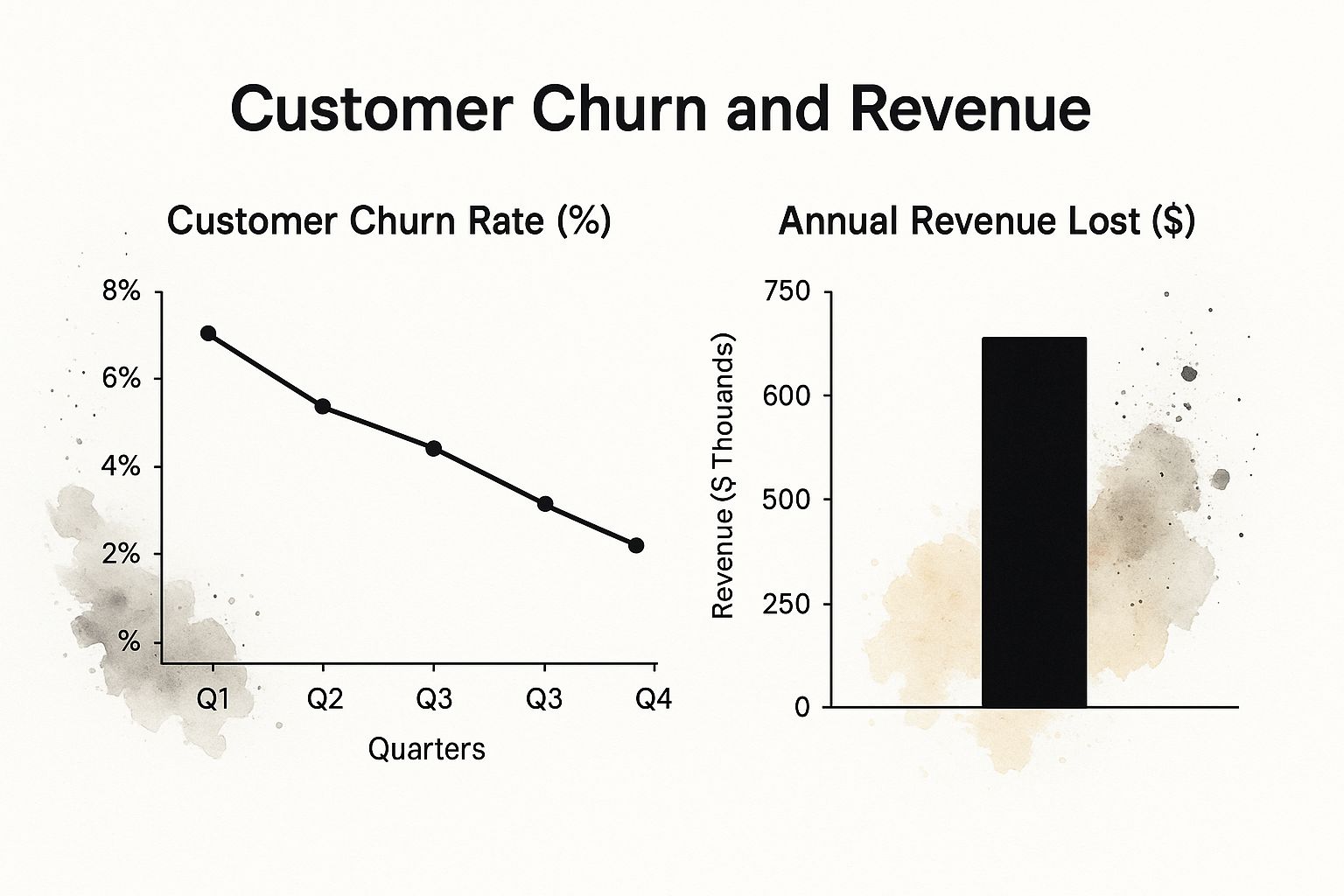Your Startup Is Leaking Customers. Stop Admiring the Puddle and Plug the Damn Hole.
Tired of useless advice? Learn how to reduce customer churn with battle-tested strategies from a founder who has actually done it. No fluff, just what works.
Posted by
Related reading
10 Voice of Customer Examples You Can Actually Use
Stop guessing. See 10 real voice of customer examples from surveys, social media, and support tickets to find out what your customers actually want.
A Founder's Guide to Analyzing Survey Data
A battle-tested approach to analyzing survey data. Learn how to turn raw feedback into actionable insights that drive real business decisions.
Customer Advisory Board: The Founder's Playbook for Avoiding Catastrophic Mistakes
A practical guide to building a customer advisory board that provides honest insights, validates your strategy, and prevents costly product mistakes.
You’re losing customers. I know you are. You’re also probably staring at a chart that shows it, calling it your “churn rate,” and talking about it in board meetings like it’s some abstract cost of doing business.
It’s not. It's a gaping wound in your hull, and you're treating it like a minor scratch.
Every founder I know worships at the altar of growth, yet they ignore the single biggest anchor dragging them down. They'll spend a fortune on ads to pour more water into a bucket riddled with holes, patting themselves on the back for "top-of-funnel growth" while their existing revenue base quietly bleeds out.
This isn’t a guide about "customer delight" or "journey mapping." This is triage. This is about grabbing a roll of duct tape and a blowtorch and doing what needs to be done to keep the ship from sinking.
The Math That Should Keep You Up at Night
That “acceptable” 5% monthly churn you glance at? It’s compounding while you sleep. A 5% monthly churn means you lose nearly half your customer base—and your revenue—every single year.
The Brutal Math of Monthly vs. Annual Churn
| Monthly Churn Rate | Annual Customer Loss | What This Actually Means |
|---|---|---|
| 3% | 30% | You're rebuilding a third of your company every year. |
| 5% | 46% | Half your customers are gone. Can you survive that? |
| 10% | 70% | You're on a hamster wheel, running just to stand still. |
| 15% | 85% | Your startup is a zombie. It just doesn't know it yet. |
This isn't a table; it's your company's life expectancy chart. At 10% monthly churn, you have to replace 70% of your customers annually just to tread water. It's a suicide mission disguised as a business plan.

We're not here to "explore solutions." We're here to stop the bleeding, now. For a deeper dive, there are proven strategies to reduce customer churn, but it all starts with one mindset shift.
The moment you treat churn as a line item on a spreadsheet, you've already lost. It’s a fire. Your job is to grab the extinguisher, not write a report about the smoke.
Takeaway: Stop admiring your churn rate and start fighting it like your company's life depends on it—because it does.
Your Customers Are Screaming the Answers. Are You Listening?

You think you "listen to customers" because you send an annual NPS survey? That’s like asking a dinner guest if they enjoyed the meal after they've already left, paid the bill, and written a scathing Yelp review. It’s a vanity exercise to make you feel good, not to fix what’s broken.
The real Voice of the Customer (VoC) isn’t in a tidy report. It’s in the rage-clicks on a buggy feature. It's in the desperate tone of a support ticket. It’s in the deafening silence of a user who hasn’t logged in for 30 days.
This isn't about making customers "feel heard." This is about building a system that pipes their raw, unfiltered pain directly to your product team so you can stop building cool new features nobody asked for and start fixing the things that are actively costing you money.
The Gold Is in the Complaints
Most founders are terrified of angry customers. They see complaints as personal attacks. Wrong. Your angriest customers are your most valuable consultants, and they're working for free. They care enough to be pissed off. The silent ones? They’ve already ghosted you.
Your job is to get your hands dirty. You, the founder, need to be reading the support tickets, the chat logs, the cancellation comments. Feel the frustration. That's how you build an intuition for what’s actually broken.
A Roadmap Built from Pain, Not Wishful Thinking
Throw out your precious feature backlog. Your new roadmap comes directly from the firehose of customer pain.
Here’s how you start, today:
- Create a
#customer-painSlack Channel: Pipe everything into it. Every support ticket, cancellation reason, negative tweet, and one-star review. Force your product and engineering leads to be in this channel. Make them watch. - Hold a Weekly "Pain Huddle": Every Friday, review the channel and ask one question: "What is the single most frustrating, churn-inducing problem we saw this week?"
- Fix That One Thing: That problem becomes the #1 priority for the next sprint. Not the shiny AI feature you want to build, but the bug that’s costing you 5% of your signups.
Ignore your customers, and you’ll be lucky to survive the quarter. Listen to their complaints, and they’ll hand you a battle-tested plan to build a product people refuse to leave.
This firehose of feedback is overwhelming by design. You're not looking for edge cases; you're hunting for patterns. When five people complain about the same broken thing in one day, that’s not an anecdote—it's a trend. That’s real data. This is the heart of Voice of Customer analysis.
Takeaway: Stop treating customer feedback like a suggestion box and start treating it like a fire alarm.
Your Onboarding Sucks, and It’s Costing You a Fortune

You spent a fortune to acquire a customer only to have them leave a week later. Sound familiar? It’s because your onboarding isn't a welcome mat—it's a brick wall.
Most founders think onboarding is a product tour. It’s not. It's a frantic race to deliver that "aha!" moment before their buyer's remorse kicks in. New users don’t want an education on your UI; they want to solve the problem that made them sign up. Fast.
Your job isn't to show them every button. It's to prove the value you promised on your pricing page, and you have about five minutes to do it.
Stop Chasing "Activation"—It's a Useless Metric
"Activation" is a garbage metric. It tells you a user completed your checklist, not that they solved their problem. A user isn’t successful because they set up their profile. They’re successful when they accomplish the one thing that made them sign up. If you don't know what that is, you have bigger problems than churn.
Forget measuring how many steps they complete. Obsess over how fast they get their first win. To stop that early churn, you need to master customer onboarding automation that shoves them directly toward that victory.
Your onboarding flow has one job: Get the user to their personal 'holy shit, this works!' moment as fast as humanly possible. Everything else is a distraction.
Find the One Action That Matters
Identify the single action that correlates most strongly with long-term retention. For an email tool, it’s sending the first campaign. For us at Backsy, it’s seeing that first actionable insight emerge from their raw feedback.
Once you know that action, your entire onboarding must be ruthlessly optimized to get them there.
- Burn Your UI to the Ground: Get rid of every pop-up, tooltip, and notification that doesn’t lead them straight to that critical action. Create a "golden path" so obvious a child could follow it.
- Be High-Touch and Scrappy: A personal welcome video from a founder can work wonders. A five-minute call to help them import their data can be the difference between a churned account and a lifer.
- Celebrate the Win: When they hit that first milestone, make them feel like a hero. Flash a message in the app. Make them feel like they accomplished something important—because they did.
Statistics show 17% of customers will leave after just one bad experience. Your onboarding is that experience. Don’t just show users your product. Make them successful with it. And the only way to know what "successful" means is to ask. Check out this guide on how to get customer feedback to stop guessing.
Takeaway: Stop showing users features and start getting them results in the first five minutes.
Stop Reacting to Churn. Go Hunt It Down.
https://www.youtube.com/embed/GeU_EtBJ3TE
If you wait for a customer to tell you they're unhappy, you’ve already lost. The cancellation email is just a formality. The breakup happened weeks ago.
Proactive retention isn't about sending a desperate "we miss you!" email. It's about seeing the signs of them leaving before they do, and intervening with a targeted, human touch. This is where the fight to reduce customer churn is won.
Most founders wait for the fire alarm. By then, the building is already engulfed in flames.
Set Your Tripwires
You need early-warning signals that an account is going cold. Forget complex AI models. Start with simple metrics that scream "this customer is slipping away!"
These are the only ones that matter at first:
- Usage Drop-Off: A daily user who hasn't logged in for a week isn't on vacation. It’s a breakup in progress. Alert on any account whose usage drops 50% over 14 days.
- Key Feature Inactivity: Every product has "sticky" features. When a customer stops using them, they're no longer getting core value. Flag accounts that go dark on these features.
- Support Silence: An engaged customer files tickets. When a chatty account goes silent, it’s not because your product is suddenly perfect. It’s because they've given up.
These aren't data points. They are cries for help.
The most dangerous customer isn't the one who complains. It's the 'silent sufferer' who quietly disengages and disappears without a word. Your job is to find them before they vanish.
Your Intervention Playbook
When a tripwire is triggered, you don't send marketing spam. You launch a human intervention. You can explore these 10 proven customer retention strategies for more, but here's a simple playbook.
Example Playbook for a Ghosting Account:
- Founder Video Message: The instant a high-value account goes quiet, record a 60-second video on your phone. "Hey [Name], it's [Your Name], founder of [Company]. Noticed you haven't been as active and wanted to personally check in. Are we still helping you solve [original problem]?" Don’t sell. Be a human.
- Offer a "Success Audit": If they don't respond, follow up. "Mind if my best product specialist and I spend 15 minutes with you? No sales pitch, we just want to make sure you're getting every bit of value you're paying for."
- The Hail Mary: If they still ghost you, send one last, brutally honest email. "Looks like we might have dropped the ball. If you have 2 minutes, I'd be grateful if you could tell me the one thing we could have done better."
This isn't about being annoying. It's about showing you give a damn.
Takeaway: Stop reacting to churn. Ambush it with proactive, personal interventions that prove you care more than your competitors.
Your Pricing Is Pushing Customers Away. Fix It.
Let's talk about the one thing founders are terrified to touch: pricing. You treat it like a sacred artifact, but it's probably one of the biggest reasons you're losing customers. A pricing model designed to close a deal is often horribly designed to keep a customer.
Your pricing tiers are full of quiet churn signals. You're losing customers not because your product sucks, but because your pricing model is actively punishing them.
Your Pricing Is a Churn Machine in Disguise
Most pricing models are flawed. They assume more usage equals more value. But what happens when usage is temporary? That’s when your pricing becomes a silent churn driver.
I see these all the time:
- The "Post-Project Purge": An agency uses your tool intensely for three months, then cancels the second the project wraps. Your pricing forced them into a high-cost tier they only needed temporarily.
- The "Perma-Tier Limbo": A customer has been on your lowest tier for two years. They aren't growing. They're just one cheaper alternative away from leaving.
- The "Penalty for Success": Your pricing accidentally punishes growth. You charge per seat, but their team is seasonal. When using your product more feels like a penalty, they start looking for the exit.
In some sectors like CPG or Wholesale, churn can be as high as 40-56%. In those markets, a rigid pricing model is a death sentence. Check out a full breakdown of churn rates by industry to see how you stack up.
Build Ramps, Not Walls
Your goal is a pricing structure that breathes with your customer's business. You need flexible off-ramps and on-ramps, not just a one-way escalator to a higher price.
A cancellation form isn't a failure; it's a conversation starter. The worst thing you can do is make "cancel" the only option when what they really need is "pause" or "downgrade."
Introduce some flexibility:
- Strategic Downgrades: Make it dead simple to downgrade to a cheaper plan. It's infinitely better to keep someone paying $29/month than to lose them entirely.
- The "Pause" Button: For seasonal businesses, a "pause" option is genius. Let them freeze their account for a tiny fee, preserving all their data. They can reactivate with one click.
- Value-Metric Alignment: Stop charging for vanity metrics. Find the one metric that truly reflects the value you provide and tie your pricing to that. Your customer's bill should feel fair when it goes up.
Rethinking your pricing isn't about charging less. It's about charging smarter.
Takeaway: Stop using your pricing to trap customers and start using it to grow with them.
No-BS Answers to Your Toughest Churn Questions
Alright, enough theory. Let's get to the raw, unfiltered answers to the questions you're actually wrestling with.
Isn't Some Churn Unavoidable? What's a Good Churn Rate?
Yes, some churn is inevitable. Companies die. But using that as an excuse for a high churn rate is founder malpractice. The whole idea of a universal "good" churn rate is a myth peddled by consultants. For a B2B SaaS, anything over 2% monthly should be a code-red fire drill.
Stop obsessing over industry averages. Your only benchmark is your own number, and whether you're making it smaller every single month.
The only "good" churn rate is one that is consistently trending downward because you are actively fighting it. Period.
My Team Is Small. How Can I Do This?
You don't need a "Head of Retention." You need a founder who gives a damn. The best retention program I ever saw started with a founder dedicating one hour a day to reading every support ticket and cancellation survey. Don't delegate feeling your customer's pain.
For proactive outreach, set one alert: which accounts have seen usage drop by 50% in the last 14 days? That’s your list. Now you, or your one CS person, can email them personally. This isn't about expensive tools; it’s about focused, manual effort.
What if My Product Just Isn't Good Enough Yet?
Then your churn isn't a metric; it's a gift. It’s a brutally honest product roadmap telling you exactly what to fix. When a customer churns for a product gap, get them on the phone. The goal isn't to save them; it's too late. The goal is to listen.
Ask them: "What was the one thing you desperately hoped our product would do that it just didn't?"
Shut up and take notes. Their answer is your next sprint priority. Early-stage churn is almost always a product-market fit problem. The path to retention is paved with the feedback from customers who left. This is also how you start improving satisfaction, and there are some proven methods for boosting customer satisfaction scores.
Should I Offer a Discount to Everyone Who Tries to Cancel?
God, no. Do that, and you just train your customers that the "Cancel" button is actually a secret "Get 15% Off" button. It's a race to the bottom that devalues your product.
Think of discounts as a scalpel, not a sledgehammer. The only time a discount is valid is when a healthy, active customer is leaving for purely "budgetary reasons." For every other reason—product gaps, bad support, lack of usage—a discount is just bribing them to stick around for another miserable month.
Fix the real problem. Don't throw money at the symptom.
Stop guessing why customers are leaving and get the cold, hard, actionable truth by analyzing their real feedback with Backsy.